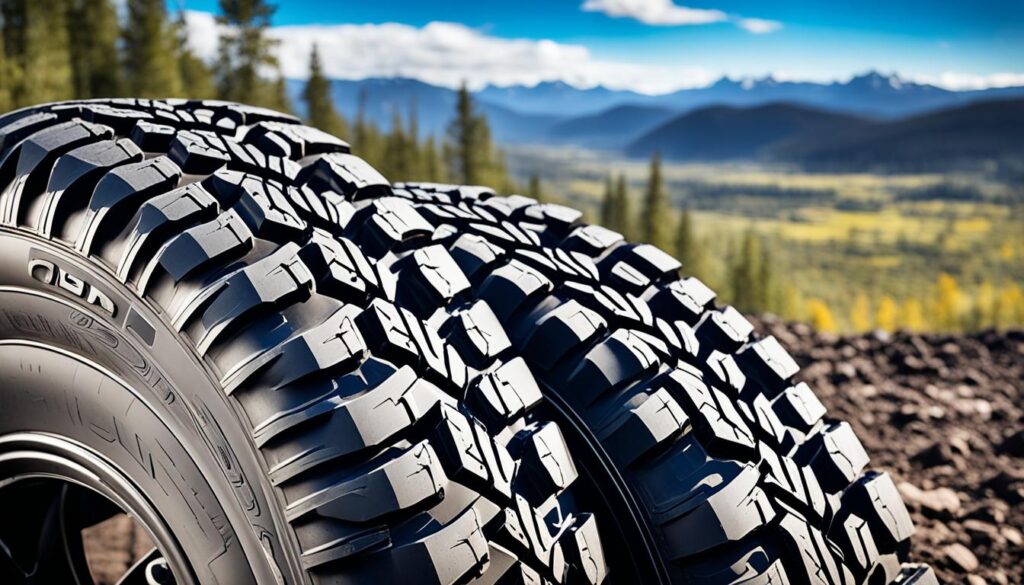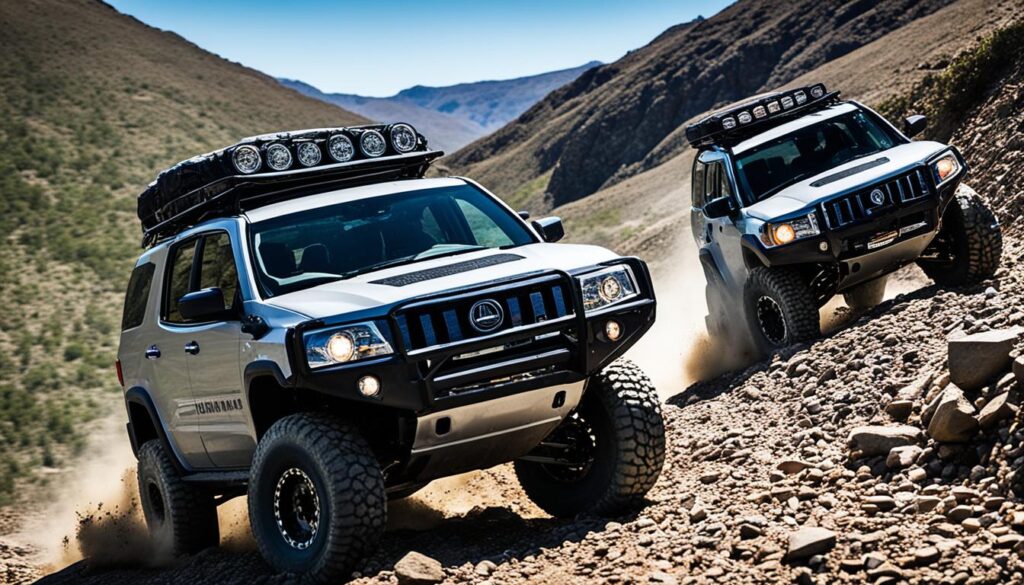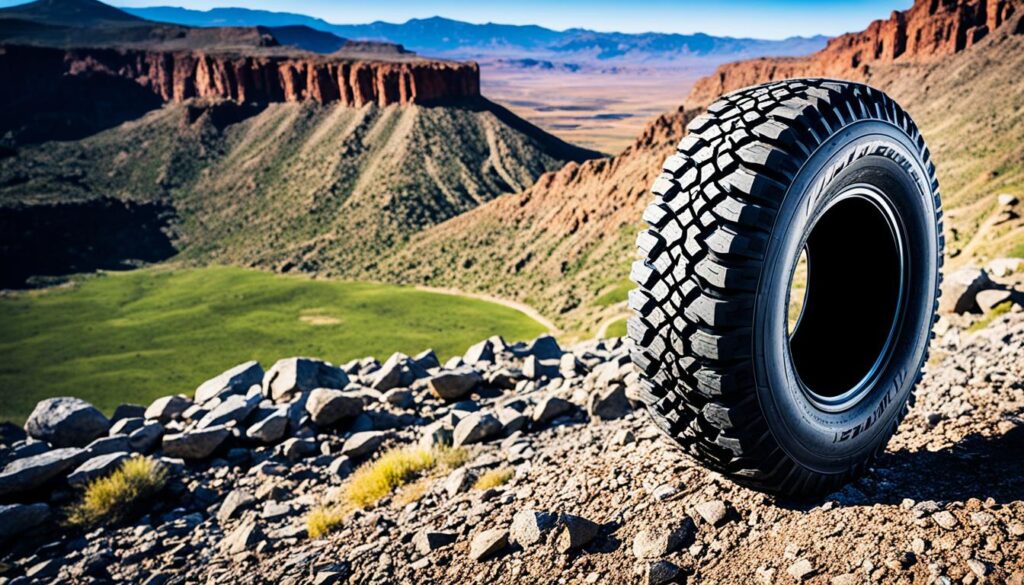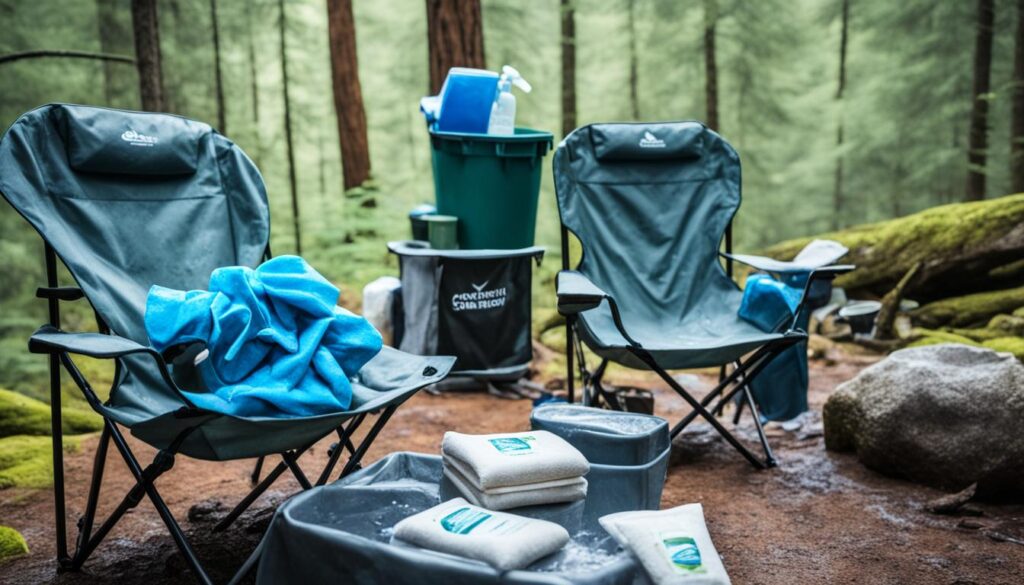Choosing the right tire size is crucial for a successful overlanding adventure. But with so many options available, how do you determine the best size tire for your off-road journeys?
In this comprehensive guide, we’ll walk you through everything you need to know about overlanding tire size. From understanding the key factors to consider to exploring the ongoing debates in the overlanding community, we’ll help you make an informed decision that enhances your off-road experience.
Key Takeaways:
- Consider factors such as sipes, tread blocks, and ply rating when choosing the best tire size for overlanding.
- Understand your vehicle’s tire size limitations and the type of terrain you’ll be traversing.
- Explore the advantages of narrow tires versus wide tires and determine what suits your needs.
- Discover the pros and cons of all-terrain, mud-terrain, and hybrid tire designs.
- Reflect on expert opinions regarding the ideal tire size for overlanding.
Choosing the right tire size is essential for a successful overlanding adventure. To determine the best tire size for your overland vehicle, you need to consider several key factors.
Tire Size Limitations
Firstly, understanding your vehicle’s tire size limitations is crucial to avoid interference with steering components and body panels. Consult your vehicle’s manual or contact the manufacturer to determine the recommended tire size range.
Terrain Considerations
The type of terrain you’ll be encountering will greatly influence the height and width of the tires you choose. Off-road conditions require larger tires with deeper tread patterns to provide better traction and stability. Consider the types of terrains you’ll be traversing, such as rocky trails, muddy paths, or sandy dunes, and select tires that are suitable for those specific conditions.
Gross Vehicle Weight
Another vital factor to consider is the gross vehicle weight. The weight of your fully packed vehicle, including all passengers, camping gear, and equipment, must fall within the load rating of the selected overland tires. Exceeding the load rating can lead to tire failure and compromise safety on the road.
By carefully considering these factors — tire size limitations, terrain conditions, and gross vehicle weight — you can determine the perfect tire size for your overlanding adventures. Remember, selecting the right tire size is crucial for optimal performance, traction, and durability both on and off the road.
Recommended Tire Size Examples
| Terrain | Tire Size (Height x Width) |
|---|---|
| Rocky Trails | 35×12.5 inches |
| Muddy Paths | 33×10.5 inches |
| Sandy Dunes | 37×13.5 inches |
These tire size examples serve as a starting point for your consideration. However, it’s essential to assess your vehicle’s specific requirements and consult with experts or professionals in the overlanding community to find the perfect tire size that suits your needs and provides optimal performance for your overland adventures.
The Great Narrow vs Wide Overland Tire Debate
When it comes to choosing overland tires, one of the ongoing debates in the community revolves around the ideal tire width. Overlanders often find themselves pondering the advantages of narrow tires versus wide tires for their off-road adventures. Each option has its own set of unique benefits, and the choice ultimately depends on the specific needs and preferences of the individual.
Advantages of Narrow Overland Tires
Narrow tires, sometimes referred to as “skinnies” or “pizza cutters,” offer several advantages that make them a popular choice among overlanders:
- Lighter Weight: Narrow tires are typically lighter compared to their wider counterparts. This weight reduction can have a positive impact on fuel efficiency and overall vehicle performance.
- Longer Contact Patch: The narrower profile of these tires allows for a longer contact patch with the ground. This increased contact area can provide better traction on various terrains.
- Better Maneuverability: Narrow tires excel in tight spaces, making maneuvering through narrow trails and congested areas easier.
- Utilitarian Vibe: Many overlanders appreciate the utilitarian aesthetic that narrow tires provide, giving their vehicles a rugged and adventurous look.
Advantages of Wide Overland Tires
On the other hand, wide overland tires offer a different set of advantages to consider:
- Better Flotation: Wider tires distribute the vehicle’s weight over a larger surface area, reducing the risk of sinking in soft terrain such as sand or mud.
- Improved Weight Distribution: The wider footprint of these tires helps in evenly distributing the vehicle’s weight, resulting in enhanced stability and traction.
- More Rugged Appearance: Many overlanders opt for wide tires for the bold and aggressive look they provide, giving their vehicles a distinctive off-road aesthetic.
When choosing between narrow and wide overland tires, it’s important to take into account the type of terrain you’ll be traversing and your personal preferences. For instance, if you frequently encounter tight, technical trails, narrow tires might be the better option due to their maneuverability. On the other hand, if you plan on tackling soft or muddy terrain, wider tires can provide better flotation and traction.
Ultimately, selecting the right tire width for your overlanding adventures depends on finding the balance between the advantages offered by narrow and wide tires, considering the specific terrain conditions and your personal preferences.
| Advantages of Narrow Overland Tires | Advantages of Wide Overland Tires |
|---|---|
| Lighter weight | Better flotation |
| Longer contact patch | Improved weight distribution |
| Better maneuverability in tight spaces | More rugged appearance |
Selecting an Overland Tire Design: All-Terrain vs. Mud-Terrain vs. Hybrid
When it comes to tire design for overlanding, there are three main options to consider: all-terrain tires, mud-terrain tires, and hybrid tires. Each design has its own unique set of characteristics and advantages, making it essential to choose the right type of tire for your overland adventures.
All-Terrain Tires
All-terrain tires are a popular choice among overlanders due to their versatility and balanced performance on both off-road terrains and paved roads. These tires feature a tread pattern that provides good traction in various conditions, including gravel, dirt, and mud. They also offer decent handling on highways, ensuring a smooth and comfortable ride. All-terrain tires often have longer tread life, making them a cost-effective option for frequent overland travelers.
Pros of All-Terrain Tires:
- Good performance on and off-road
- Versatile tread pattern for various terrains
- Decent handling on highways
- Longer tread life
Cons of All-Terrain Tires:
- Not as aggressive as mud-terrain tires in extreme off-road conditions
- Less traction in deep mud or on slippery surfaces
Mud-Terrain Tires
If you frequently encounter soft and muddy terrains during your overlanding expeditions, mud-terrain tires are an excellent choice. These tires feature larger tread lugs with deeper grooves, ensuring superior traction and self-cleaning capabilities in mud, sand, and other challenging off-road conditions. Mud-terrain tires also offer better gravel ejection, preventing rocks from getting stuck in the tread. However, it’s important to note that these tires may generate more noise and provide a slightly rougher ride on paved roads.
Pros of Mud-Terrain Tires:
- Aggressive tread pattern for excellent off-road traction
- Superior performance in soft and muddy terrains
- Improved gravel ejection
Cons of Mud-Terrain Tires:
- Noisier and rougher ride on highways
- Shorter tread life compared to all-terrain tires
Hybrid Tires
Hybrid tires aim to combine the best aspects of all-terrain and mud-terrain designs. They offer a mix of aggressive off-road capabilities and on-road comfort. Hybrid tires typically feature a tread pattern that provides enhanced traction in challenging off-road terrains, while still maintaining decent handling on highways. These tires are a good option for overlanders who want an all-around tire that can handle a variety of terrains without compromising too much on-road performance.
Now, let’s take a look at a visual comparison of the different tire designs:
| All-Terrain Tires | Mud-Terrain Tires | Hybrid Tires |
|---|---|---|
 |
As you can see, the choice between all-terrain, mud-terrain, and hybrid tires ultimately depends on the type of terrain you’ll encounter during your overlanding adventures. Consider the specific needs of your journeys and weigh the pros and cons of each tire design before making a decision. Remember, selecting the right tire design is crucial for optimizing your vehicle’s performance and ensuring a successful and enjoyable overland experience.
Expert Opinions: Skinny vs Fat Overland Tires
As an overlander, choosing the right tire size is essential for optimal performance on and off the road. When it comes to the debate of skinny vs fat overland tires, there are varying opinions within the overlanding community. Some overlanders prefer the traction and maneuverability of skinny tires, while others appreciate the flotation and rugged appearance of fat tires.
Experiences with skinny overland tires have shown advantages such as improved fuel consumption, lighter weight, and a longer contact patch. These tires are often praised for their ability to provide precise steering control and maneuverability in tight spaces. With their narrow width, they can cut through soft terrain more effectively, providing enhanced grip.
Fat overland tires, on the other hand, offer benefits like improved flotation over sand, mud, and snow, as well as a more aggressive look. These wider tires distribute the vehicle’s weight over a larger surface area, resulting in better weight distribution and reducing the risk of sinking into soft terrain. The larger contact patch provides excellent stability and increased sidewall strength, making them suitable for challenging off-road conditions.
When considering the best tire size for overlanding, it’s important to take several factors into account. The vehicle weight, power-to-weight ratio, fuel consumption, terrain conditions, and personal preferences all play a role in determining the ideal tire size. A balance must be struck between traction, flotation, maneuverability, and fuel efficiency.
“I’ve been using skinny overland tires for years, and they have proven to be a game-changer for me. The improved maneuverability and traction in tight spots have allowed me to explore off-the-beaten-path destinations without any worries. It’s a trade-off between flotation and grip, but for my style of overlanding, skinny tires work wonders.” – John, experienced overlander
“I prefer fat overland tires for my off-road adventures. The improved flotation and aggressive look give me the confidence to tackle any terrain. It’s true that they may not offer the same level of maneuverability as skinnies, but for the type of exploration I do, the benefits outweigh the compromises.” – Sarah, seasoned overland enthusiast
Ultimately, the effectiveness of skinny vs fat overland tires depends on your specific needs, vehicle setup, and the type of terrain you’ll be traversing. It’s highly recommended to consult with experienced overlanders, conduct thorough research, and consider your own preferences before making a decision. The key is to find the tire size that not only suits your vehicle but also enhances your overall overlanding experience.
For a visual representation, take a look at the comparison table below:
| Skinny Overland Tires | Fat Overland Tires | |
|---|---|---|
| Advantages |
|
|
| Considerations |
|
|
Remember, personal experiences and the opinion of fellow overlanders are valuable, but the best tire size for overlanding is the one that aligns with your specific needs, vehicle capabilities, and desired level of performance. So, get out there, explore, and find the tire size that will take you on unforgettable overland adventures.

Conclusion
Selecting the best tire size for overlanding requires careful consideration of several factors. By understanding your vehicle’s tire size limitations, assessing the terrain conditions you’ll be encountering, and taking into account your vehicle’s weight, you can make an informed decision that will enhance your overland adventures.
Whether you opt for narrow or wide tires, it’s essential to find a balance that suits your needs. Narrow tires provide advantages such as lighter weight and improved maneuverability in tight spaces. On the other hand, wider tires offer better flotation and weight distribution. By analyzing the type of terrain you’ll be traversing and considering your personal preferences, you can determine which tire width is best for your overland journeys.
Additionally, the choice between all-terrain, mud-terrain, or hybrid tire designs depends on your specific requirements. All-terrain tires offer a compromise between on-road and off-road performance, while mud-terrain tires excel in challenging terrain conditions. Hybrid tires attempt to combine the best elements of both designs. Consider your intended usage and prioritize the features that matter most to you when selecting the tire design that will best meet your needs.
In conclusion, by carefully assessing tire size limitations, terrain conditions, vehicle weight, and personal preferences, you can confidently determine the best tire size for your overlanding adventures. It’s crucial to strike a balance between traction, durability, and performance to ensure a safe and enjoyable journey. So, get out there and explore the great outdoors with the perfect tires for your overland vehicle!
FAQ
What factors should I consider when choosing the best tire size for overlanding?
When choosing the best tire size for overlanding, consider your vehicle’s tire size limitations, the type of terrain you’ll encounter, and the gross vehicle weight.
Should I choose narrow or wide tires for overlanding?
The choice between narrow and wide tires depends on the type of terrain you’ll be traversing and your personal preferences. Narrow tires offer lighter weight and better maneuverability, while wider tires provide better flotation and weight distribution.
What are the different tire designs available for overlanding?
The main tire designs for overlanding include all-terrain, mud-terrain, and hybrid tires. All-terrain tires offer a balance between off-road and on-pavement performance, mud-terrain tires excel in soft terrain conditions, and hybrid tires attempt to bridge the gap between the two.
What are the advantages of narrow overland tires versus fat overland tires?
Narrow overland tires offer advantages such as lighter weight, longer contact patch, and better maneuverability in tight spaces. Fat overland tires provide better flotation, improved weight distribution, and a more rugged appearance.
What is the best tire size for overlanding?
The best tire size for overlanding depends on your specific needs, vehicle weight, terrain conditions, and personal preferences. It’s important to find a balance that provides optimal traction and durability for off-road exploration.






